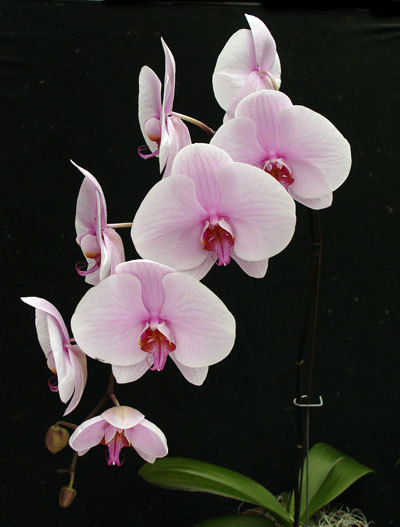To some minds, the poinsettia is cheapened by its ubiquity. But somehow that everywhere orchid, the phalaenopsis or moth orchid, always seems elegant and exotic, even when herded in the big-box store or supermarket.
Mass cloning techniques and industrial-scale propagation in places like Taiwan have kept the market well-fed with unnamed varieties, big whites, pinky purples and weird bicolors, that seem as abundant and non-seasonal as potatoes. Still, the tree-dwelling jungle plant lends grace to its surroundings, the condo lobby, the swanky restaurant or your kitchen countertop. Does anyone not like a moth orchid?
But this affection, I wager, is accompanied by an underlying anxiety that we will kill the plant through neglect or abuse. Getting the most from a moth orchid, eight weeks of bloom and repeat flowering in a few months, is not difficult but requires method.
In search of the best advice, I traveled to the Floradise Orchids greenhouse of Janet Cherchuck and Stephen Shifflett, 100 miles south of Washington in Gordonsville, Va., where the couple has been raising orchids commercially for more than 30 years.
Moth orchids have light and temperature needs, but the single biggest reason they crash, said Cherchuck, is through incorrect watering: usually overwatering, sometimes underwatering, or a combination of the two. Typically, the roots begin to rot and the leaves grow limp.
Getting it right is complicated by the type of growing medium used: either a loose mix of pine bark or sphagnum peat moss. In either case, the orchid should be thoroughly watered and not watered again until nearly dry. The more densely packed moss takes longer to dry and may need watering every 10 to 14 days compared with the weekly pine bark watering, but the timing varies by light levels, warmth and humidity. Use your finger to probe about an inch into the pot to see if the surface is dry. Another way to tell: A watered pot feels heavier than one that is dry.
At a sink, run the orchid under a tap of room-temperature water, neither hot nor cold, and let at least a gallon run through the drain holes to ensure complete saturation. With open-growing media in free-draining pots, “watering is about frequency, not quantity,” said Cherchuck. Feed with a weak soluble fertilizer after watering. It’s OK to get the leaves wet, but not the flowers. Finally, tip the plant to remove water from the leaf bases and crown, where the stem meets the roots.
Once the flowers have finished, you can cut to just above a node to promote a new flowering stem. This will appear in a few weeks if the plant is happy. This constant blooming, however, will stress the plant, and the subsequent blooms will be smaller and fewer. If you want to build up your orchid for long-term cultivation, cut off the flower stem and in June, place the orchid outside in a shady, sheltered spot away from direct sunlight. Continue to water and feed as the growing medium dries; don’t rely on rainfall. The required difference in day and night temperatures outside will encourage the plant to bloom after you bring it back indoors in early fall.
Small phalaenopsis varieties, with different bloodlines, can bloom more freely than large hybrids and are a good choice for apartment dwellers who have no yard for summer care.
Send questions/comments to the editors.



Success. Please wait for the page to reload. If the page does not reload within 5 seconds, please refresh the page.
Enter your email and password to access comments.
Hi, to comment on stories you must . This profile is in addition to your subscription and website login.
Already have a commenting profile? .
Invalid username/password.
Please check your email to confirm and complete your registration.
Only subscribers are eligible to post comments. Please subscribe or login first for digital access. Here’s why.
Use the form below to reset your password. When you've submitted your account email, we will send an email with a reset code.